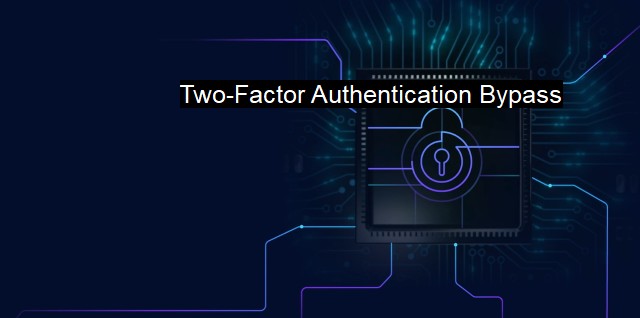What are Two-Factor Authentication Bypass?
Mitigating Vulnerabilities in Two-Factor Authentication (2FA): Strategies to Combat 2FA Bypass and Social Engineering Tactics
Two-factor authentication, commonly known as 2FA, is a standard security tool used to strengthen the security system, often surrounding access to technology systems in various domains. While the conventional username and password system provides the first layer of security, two-factor authentication contributes by adding a second level. This additional measure usually involves sending a unique one-time code or OTP to a user's device or requiring a biometric input, such as a fingerprint. using two-factor authentication provides supplementary protection and minimizes the risk of major security breaches.As advanced as security measures may be, motivated bad actors have devised methods to overcome them. Two-factor authentication bypass involves methods used by hackers to sidestep this added security layer and unauthorized access to secured resources. This bypass can take several forms, including social engineering, man-in-the-middle attacks, and exploitation of account recovery mechanisms.
With sophisticated phishing techniques and social engineering, attackers trick their victims into sharing their one-time passcodes or resetting their 2FA settings. In many occurrences, the attackers impersonate authentic organizations. They claim that the user's security is at risk, thus persuading the victim to share their details.
Man-in-the-middle attacks, on the other hand, involve an attacker who intercepts communication between two parties without their knowledge. With man-in-the-middle attacks, criminals intercept 2FA passcodes sent over the network to gain unauthorized access. In most cases, this bypass technique requires a significant degree of codified knowledge and a direct line of communication with the victim's connection.
A support mechanism that can be exploited for 2FA bypass is the account recovery process. Users frequently forget their passwords, prompting organizations to factor in component keys that grant account recovery access, usually tied to options like recovery emails or backup phone numbers. Knowing that these mechanisms exist, hackers endeavor to gain access to these backup preferences or find ways to reset them, consequently weakening the encompassing security net.
Software vulnerabilities can also lead to a two-factor authentication bypass. Such weaknesses are often exploited by hackers by injecting malicious code and thereby gaining unauthorized access to users' confidential data or even gaining control over an entire system. Targeting such software vulnerabilities often requires a high level of skill and expertise on the attackers' part.
While two-factor authentication dramatically enhances security, it is imperative to understand that the measure is not completely invulnerable. Therefore, anticipatory measures like social-awareness training, regular software updates, and account recovery protocols' examinations are necessary to prevent two-factor authentication bypass.
Most importantly, such issues underline the importance of robust and well designed cybersecurity measures. Organizations should adopt security practices beyond two-factor authentication, like encryption and anomaly detection, constantly updating these measures according to evolving threat landscapes. regularly conducting security awareness training can ensure that end-users understand the importance of following secure practices, such as not sharing sensitive information, regularly updating passwords, or downloading resources from unknown or unverified sources.
While the two-factor authentication bypass is an existing threat awareness and proactivity can significantly minimize its risks. It is a lesson to organizations and individual users alike that while safeguards are essential, securing access to sensitive resources is an ongoing process that must adapt to progressively sophisticated threats.
A holistic approach can and must entail technology, policy, and people to ensure effective cybersecurity posture. This must encompass state-of-the-art technology and practices endorsement of detailed and pragmatic security policies, and a well-informed user base that proactively engages in secure technology-use behavior.

Two-Factor Authentication Bypass FAQs
What is two-factor authentication bypass?
Two-factor authentication bypass refers to the process of overcoming two-factor authentication security measures without the need for a valid authentication code. It is a security vulnerability that allows attackers to gain unauthorized access to user accounts.How do cybercriminals bypass two-factor authentication?
Cybercriminals can bypass two-factor authentication by using various techniques such as social engineering, SIM swapping, and man-in-the-middle attacks. They can also exploit vulnerabilities in the authentication system or steal authentication codes through phishing attacks or malware.Why is two-factor authentication bypass a major concern in cybersecurity?
Two-factor authentication bypass is a major concern in cybersecurity as it allows attackers to gain unauthorized access to sensitive information and assets. This can lead to data breaches, financial losses, and reputational damage for individuals and organizations.How can I protect myself from a two-factor authentication bypass attack?
To protect yourself from a two-factor authentication bypass attack, you should use strong and unique passwords, enable multi-factor authentication, and be cautious of phishing emails and suspicious links. You should also keep your antivirus software updated and avoid using public Wi-Fi networks for sensitive tasks.| | A | | | B | | | C | | | D | | | E | | | F | | | G | | | H | | | I | | | J | | | K | | | L | | | M | |
| | N | | | O | | | P | | | Q | | | R | | | S | | | T | | | U | | | V | | | W | | | X | | | Y | | | Z | |
| | 1 | | | 2 | | | 3 | | | 4 | | | 7 | | | 8 | | |||||||